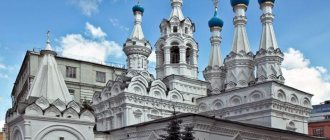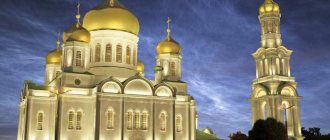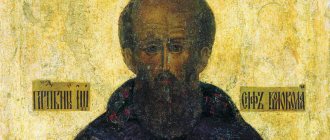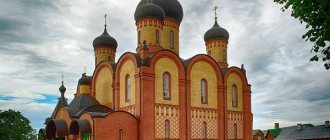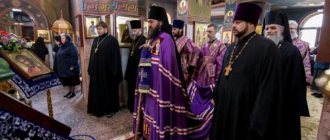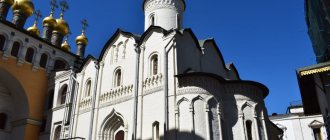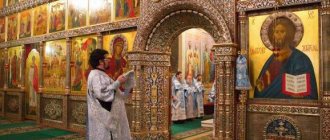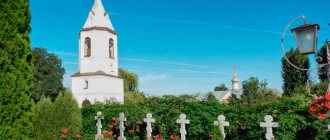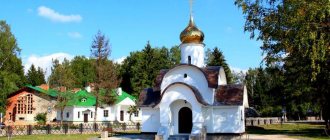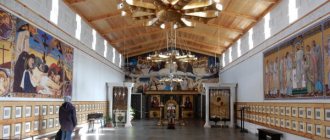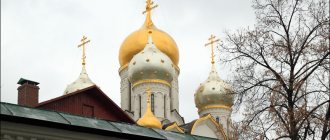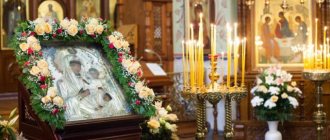Mir
Ukraine Sumy region Putivl Nativity of the Blessed Virgin Mary Molchensky Convent Map loading in progress...
{"format":"leaflet","minzoom":false,"maxzoom":false,"limit":50,"offset":0,"link":"all","sort":[""], "order":[],"headers":"show","mainlabel":"","intro":"","outro":"","searchlabel":"\u2026 \u0441\u043b\u0435\ u0434\u0443\u044e\u0449\u0438\u0435 \u0440\u0435\u0437\u0443\u043b\u044c\u0442\u0430\u0442\u044b","default":"","import-annotation":false,"width ":"auto","height":"350px","centre":{"text":"","title":"""link":"""lat":51.32547600000000187492332770489156246185302734375,"lon": 33.8754330000000010159055818803608417510986328125,"icon":""},"title":"","label":"","icon":"","lines":[],"polygons":[],"circles":[ ],"rectangles":[],"copycoords":false,"static":false,"zoom":8,"defzoom":14,"layers":["OpenStreetMap"],"image layers":[] ,"overlays":[],"resizable":false,"fullscreen":true,"scrollwheelzoom":true,"cluster":false,"clustermaxzoom":9,"clusterzoomonclick":true,"clustermaxradius":80, "clusterspiderfy":true,"geojson":"","clicktarget":"","showtitle":true,"hidenamespace":false,"template":"","userparam":"","activeicon": "","pagelabel":false,"ajaxcoordproperty":"","ajaxquery":"","locations":[{"text":"\u003Cb\u003E\u003Ca href=\"/palomnik/%D0% A0%D0%BE%D0%B6%D0%B4%D0%B5%D1%81%D1%82%D0%B2%D0%B0_%D0%9F%D1%80%D0%B5%D1%81% D0%B2%D1%8F%D1%82%D0%BE%D0%B9_%D0%91%D0%BE%D0%B3%D0%BE%D1%80%D0%BE%D0%B4%D0% B8%D1%86%D1%8B_%D0%9C%D0%BE%D0%BB%D1%87%D0%B5%D0%BD%D1%81%D0%BA%D0%B8%D0%B9_% D0%B6%D0%B5%D0%BD%D1%81%D0%BA%D0%B8%D0%B9_%D0%BC%D0%BE%D0%BD%D0%B0%D1%81%D1% 82%. u0442\u043e\u0439 \u0411\u043e\u0433\u043e\u0440\u043e\u0434\u0438\u0446\u044b \u041c\u043e\u043b\u0447\u0435\u043d\u0441\u0 43a\u0438\u0439\u0436\u0435\ u043d\u0441\u043a\u0438\u0439 \u043c\u043e\u043d\u0430\u0441\u0442\u044b\u0440\u044c\»\u003E\u0420\u043e\u0436\u0434\u0435\u 0441\u0442\u0432\u0430\ u041f\u0440\u0435\u0441\u0432\u044f\u0442\u043e\u0439 \u0411\u043e\u0433\u043e\u0440\u043e\u0434\u0438\u0446\u044b\u041c\u0 43e\u043b\u0447\u0435\u043d\ u0441\u043a\u0438\u0439 \u0436\u0435\u043d\u0441\u043a\u0438\u0439 \u043c\u043e\u043d\u0430\u0441\u0442\u044b\u0440\u044c\u0 03C/a\u003E\u003C/b\ u003E","title":"\u0420\u043e\u0436\u0434\u0435\u0441\u0442\u0432\u0430 \u041f\u0440\u0435\u0441\u0432\u044f\u0442\u043e\u0439 \u0 411\u043e\u0433 \u043e\u0440\u043e\u0434\u0438\u0446\u044b \u041c\u043e\u043b\u0447\u0435\u043d\u0441\u043a\u0438\u0439 \u0436\u0435\u043d\ u0441\u043a\u0438\u0439\u043c \u043e\u043d\u0430\u0441\u0442\u044b\u0440\u044c","link":"","lat":51.32547600000000187492332770489156246185302734375,"lon":33.875433 0000000010159055818803608417510986328125,"icon":""}],"imageLayers": []}
51.325476; 33.875433
Ukraine, Sumy region, Konotop district, Putivl, Seimskaya street, 1
Putivl, Sumy region
Ukraine
Telephone:
(0544) 25-50-49,
Telephone:
+38 (05442) 5-21-23,, (099) 071-17-51
Nativity of the Virgin Mary Molchensky Pechersky Monastery
- convent of the Konotop diocese of the Ukrainian Orthodox Church. Located in the city of Putivl.
History[edit]
At the end of the 16th century, a stone citadel was built in Putivl on the site of an ancient Russian wooden fort. It was called the Kremlin and was hexagonal in plan, with round corner towers and a square gateway.
The relatively low walls had three tiers of loopholes. The French traveler Jacques Margeret, having visited Putivl, wrote: “In Russia, castles and fortresses are wooden, with the exception of Moscow, Smolensk, Ivan-Gorod, Tula, Kazan, Astrakhan and Putivl...”
Knowing the reliability of the Putivl fortress, as is known, the monks of the suburban Molchensk Hermitage (now Sophronievsky Monastery) settled here in 1592. They erected a stone church of the Nativity of the Blessed Virgin Mary in the middle of the fortress courtyard, and soon took over the entire fortress, turning it into a monastery. In the event of an enemy attack, the monks were obliged to defend the monastery-fortress.
The history of the Molchensky Monastery is closely connected with such a well-known period in Russian history as the “Time of Troubles.”
In 1598, after the death of Tsar Fyodor Ivanovich, the Rurik dynasty ended; Boris Godunov ascended the throne. There were persistent rumors among the people that the legal heir, Tsarevich Dmitry (son of Ivan the Terrible), was killed in Uglich in 1591 on the orders of Godunov.
Taking advantage of the acute political situation, the monk of the Moscow Chudov Monastery Grigory Otrepiev fled to Poland, where he began to impersonate Tsarevich Dmitry, who supposedly miraculously escaped massacre. Polish feudal lords decided to use “False Dmitry” for their own purposes. They equipped a large army for a campaign against Moscow, hoping to annex Russian and Ukrainian lands to their possessions. In particular, the impostor promised to give the Putivl lands to his patron and father-in-law, the Sandomierz governor Yuri Mnishek.
In the Battle of Dobrynichi (1604), the army of Boris Godunov defeated False Dmitry, and he was forced to retreat to Putivl and strengthen himself there. Putivl and many cities of the Seversk land went over to the side of the impostor. The historian N.M. Karamzin explains the reason for such success of the “undressed” by the fact that “the old Lithuanian spirit still lived here. There was a crowd of villains, fugitives, disgraced servants; they naturally expected rebellion as happiness.” This idea is confirmed by the statement of the Dutch merchant Isaac Massa, who called Putivl “the head and instigator of all rebellious cities.”
The residence of False Dmitry in Putivl became a stone fortress, or more precisely, the Cathedral of the Nativity of the Blessed Virgin Mary of the Molchensky Monastery. The impostor's room, the "secret octagonal chamber", was located in the upper tier of the cathedral's main tower.
For four months, while in the Molchensky Monastery, he sent out “lovely letters” in which he informed the people about his “miraculous salvation” and called for a fight against Boris Godunov.
Having gathered a new army (40 thousand people) in Putivl and its environs, the impostor in 1605 moved to Moscow. At this time, Tsar Boris Godunov unexpectedly died, and False Dmitry easily managed to take the Moscow throne. However, after reigning for only about a year, the impostor was killed.
During the “time of troubles”, between 1606 and 1612, the Molchensky Monastery burned down several times, was rebuilt and was re-consecrated in 1630. At the turn of the XVII-XVIII centuries it was greatly reconstructed. The building acquired the features of Ukrainian Baroque.
At the end of the 17th century, having lost its significance as a border fortress, Putivl fell into decay. If earlier, in the words of the same False Dmitry I: “honey and milk were boiling here, the most distinguished Greek merchants were trading in gold, silver, patterned stones and expensive goods,” but now the fortress city was turning into a provincial, provincial town.
Along with the city, the Molchensky Monastery also fell into decay. During the reign of Catherine II, he lost his estates, lands and peasants. And it was transferred to the status of a “3rd class monastery.” This gave the right to maintain only a small staff in the monastery: the abbot and 12 monks. The measured, godly life of the monastery was interrupted by the “new turmoil” that befell everyone in 1917. The so-called “October revolution” turned everything upside down and destroyed the old foundations.
In the early 20s of the 20th century, as a result of a barbaric anti-religious campaign, the monastery was devastated and plundered. And after a deliberate arson it was abolished and thrown into oblivion for many years. In the late 40s, however, they remembered it and, having destroyed the magnificent Church of John the Baptist, converted it into a vocational school. In the 50s, the monastery housed a factory for radio components for the military-industrial complex. And in the former temples powerful presses began to work, destroying the ancient walls... Everything around was polluted with mercury...
People and names changed, but the prayed walls continued to live their own lives. This was indicated by the crosses on the cathedral church, which they never dared to remove...
Hope for salvation appeared in 1987, when the Molchensky Monastery (or rather its remains) became one of the key objects of the Putivl historical and cultural reserve. And finally, in 1992, after seven decades of destruction, the monastery was returned to the fold of the church. Here, like many centuries ago, a male monastery was located.
Since 1997, by decision of the Synod of the Ukrainian Orthodox Church, the status of the monastery was changed, it became female. From that moment on, the holy monastery began to be revived. With God's help, with the help of caring people, parishioners of the monastery and the efforts of the monastics themselves, the restoration of the ancient monastery, this unique architectural monument of the 17th century, is being carried out.
Dear parishioners, pilgrims, guests of the city, and everyone who is not indifferent to spiritual shrines, we believe and hope that with your help, this ancient holy monastery will not cease to transform to the problem of our common spiritual cleansing and repentance.
We ask everyone who has the opportunity to make their contribution to the revival of this spiritual stronghold, so that with the renewal of the architectural heritage, the prayers offered for all of you throughout the centuries will be strengthened and strengthened. And the Mother of God, patroness of the Christian race, will beg Her Son, rich in all kinds of gifts and blessings, to reward you a hundredfold in this temporary, and most of all in the future, eternal life. Amen.
The current state of the Sophronievsky Monastery
Archimandrite Nikolai has been heading the holy monastery since 2009 and is doing everything to reconstruct and preserve the ancient monastery. The symbol of eternity of the Sophronievo complex is the centuries-old oak trees growing near its walls; all visitors to the monastery try to hug them.
The restoration of the road to the village of Novaya Sloboda, which is located a few kilometers from Putivl, contributed to the growth of pilgrims visiting the shrine all year round.
The atmosphere of purity and light is felt from the first moment of being in temples with a centuries-old history. Those who have visited here once are sure to return again; many have a desire to live within the walls of the monastery for at least a few days in order to be filled with God’s grace.
Shrines[edit]
* Molchenskaya miraculous icon of the Mother of God.
Molchensk Icon of the Mother of God
The celebration of the miraculous image of the Molchensk Icon of the Mother of God takes place on May 7 (transfer of the icon) and October 1 (appearance of the icon).
The Molchenskaya miraculous icon of the Mother of God is a large Shrine of the Nativity of the Blessed Virgin Mary of the Molchensky Pechersky Convent of the city of Putivl, which is located in the northern part of the Sumy region in the Konotop-Glukhov diocese.
The Most Holy Theotokos covered the land of Putivl with the holy omophorion, appearing miraculously in the Molche swamp on October 1 (New Style) 1405.
The area was uninhabited. And people forgot that in the 12th-13th centuries ascetic monks from the Kiev Pechersk Lavra lived and died there. But the Lord and the Most Holy Theotokos did not forget this place of exploits. Through the prayers of the holy elders, the image of the Mother of God shone with an indescribable light on a tree near the Molchensky swamp. The beekeeper who found the icon was amazed by what he saw and fell to his knees in awe. Suddenly, a loud unknown voice announced: “Let the Church of the Most Holy Theotokos be built in this place.” He hurried to Putivl with the news of the miracle and the command of the Mother of God to dedicate a temple to Her.
Under the ringing of bells, the clergy and many people immediately went to the indicated place and then everyone saw the icon surrounded by heavenly light. A prayer service was performed here and people received many healings.
A chapel was erected on this site, and subsequently a church in the name of the Nativity of the Blessed Virgin Mary and a monastery was founded - Molchenskaya Hermitage.
In troubled times, the monastery was destroyed, and the monks of the country desert were forced in 1605 to move to a newly built monastery on the territory of the Putivl fortress, called Bolshoi Molchensky. The monks brought the Holy Molchensk Icon with them.
As is known from the report of Abbot Manuel to the Holy Synod, which was kept in the local history museum, the prototype died in a fire. But by the grace of God, the first copy of the Molchensk Icon of the Mother of God, written in 1724 under Abbot Moses, who became famous for many miracles and is miraculous, has been preserved.
This list was especially revered in the Seversk land. The people of Putivli did not make a single business or a single decision without prayer before the miraculous image. Through the prayers of the Mother of God, many people received healing and consolation in sorrows and troubles.
After the monastery was closed in 1923, the Molchenskaya Icon of the Mother of God disappeared. For many years, the orphaned Putivlyans searched hopelessly for their Shrine.
In the 60s, Fr. was appointed dean of the Putivl and Burynsky districts and rector of the Transfiguration Cathedral. Georgy (Kozachenko). He was especially interested in the history of the Molchensk Icon, and he fervently prayed that the Queen of Heaven would reveal the location of Her miraculous image. But there was no information. And only in 1969 to Fr. Mrs. Sekerina came to George (as evidenced by the historical act) and handed over to the priest the icon bequeathed to her by her late husband, the elder of the St. Nicholas Church, which represents the Great Shrine for Putivl. The priest’s heart trembled; he expected to see the Molchenskaya Icon of the Mother of God. But the woman brought the 19th century Vladimir icon with letters in a large wooden icon case. Father had difficulty holding back tears of disappointment, but to console Mrs. Sekerina he accepted the icon. Father George lit a lamp in front of her and began to pray, but an unknown force compelled her to open the icon case. As it turned out, under the Vladimir image of the Mother of God the miraculous ancient icon of Molchenskaya was kept.
During the difficult years of atheism, the icon was secretly kept in the priest's house. After the opening of the Putivl Monastery, on May 7 (New Style), 1995, in a procession of the cross, the icon was transferred to the Transfiguration Cathedral, where the Divine Liturgy was celebrated and a prayer service was served before the miraculous image of the Mother of God of Molchensk. After the prayer singing was completed, the icon was very solemnly transferred to its native Molchensko-Putivl monastery.
And again the suffering flowed to the healing spring of the Mother of God, who began to warm their frozen hearts, filling them with grace. The Queen of Heaven shows many miracles and healings to those who pray with faith before her miraculous image. And as noted, the icon has a special grace to help patients with cancer. There is evidence of healings. The Mother of God of Molchensk is called the Healer. The icon also helps students.
Sights of Putivl
Sofronievsky Monastery
Two kilometers from the village of Novaya Sloboda, Putivl district, on high hills above the flat floodplain of the Seim, among an oak forest, there is a unique complex of the Sofronievsky Monastery (formerly the countryside Molchansky Monastery).
According to chronicles, it was founded in 1405, and received its name from the huge impassable swamp Molche, in the floodplain of the Seim. Initially, all the buildings of the monastery were wooden. At the end of the 16th century, the monks founded their compound in the Putivl Kremlin, and then, in connection with the events of the so-called “Time of Troubles,” at the beginning of the 17th century they finally moved to Putivl. The monastery in the forest was abandoned, and only in the 30s of the 17th century the first stone Church of the Nativity of the Virgin Mary was built there. Under Abbot Sophronia from 1653, the monastery expanded greatly. Many new buildings appeared, and in order not to confuse it with the Putivl Molchansky Monastery, it was given the name Sophronium Hermitage. By the middle of the 18th century, the Sofronievsky Monastery had turned into a large complex complex, which consisted of civil and religious buildings from various periods of construction.
To date, three above-ground structures have survived: the refectory of the late 17th century, the gateway Church of the Intercession, built in the mid-18th century, the abbot’s building from 1911, and partly the fence with a gate.
The expressive silhouette of the gate church greets the traveler coming out to the edge along the forest road. The church is two-tiered. The first tier has a passage arch in the center and arched doorways on the sides. The second tier is a very slender three-part one-domed temple in the spirit of “Elizabethan Baroque”, with lush architraves over the windows, curved cornices and an elegant Baroque dome top.
To the left of the gate church, on a separate hill, you can see the rectangular building of the refectory. It is one-story, with a semi-basement, and has a very interesting system of vaulted ceilings. In particular, the refectory hall on the first floor has two pillars. This is the only example of this kind in Ukrainian architecture. The external decor of the refectory is austere and laconic.
In contrast, the rector’s building, built in the neo-Russian style with richly profiled cornice rods, platbands, and various semi-columns, amazes with its wealth of decorations. The most complex decorative details are made with high precision from shaped bricks, which indicates the highest quality of construction work.
However, the most interesting part of the Sofronievsky Monastery is underground. And the point is not only that even with a cursory inspection, the bases of walls and the foundations of many structures are visible in the ground. On the eastern slopes of the two monastery mountains there are several cave complexes dug in loess soils, similar to the famous caves of the Kiev Pechersk Lavra. They are still practically unexplored. Experts date the oldest of them to the 13th-14th centuries. Cave labyrinths consist of passages, cells, and niches-arcasolia for burials. Large rooms are also available. Apparently these are underground churches and chapels.
Another very interesting circular underground labyrinth is located on the southeastern slope of the monastery mountain, almost at the very surface. Its walls and vaults are lined with brick, which dates back to the 18th century. The most unusual thing here is the vaulted underground church. Its vaults are tightened with iron ties laid in the masonry. This is indisputable evidence that this labyrinth was built in an open way: first they dug a large pit, built vaulted passages and cells from brick, and then covered it all with earth.
The caves of the Sophronievsky Monastery await explorers. They still keep many secrets.
Transfiguration Cathedral
1617-93 The Transfiguration Cathedral (first half of the 17th century) is a work of ancient Russian architecture. Its most ancient part - the main cubic mass - is crowned with five decorative onion-shaped heads on narrow round neck-drums. It is surrounded on three sides by a closed one-story porch (to the northern wall of which is adjacent a single-apse, single-domed chapel), and on the fourth, eastern side, one low apse protrudes. Thus, from the rather low volumes of the porch, chapel and apse, a mighty cube of the main temple seems to grow. The planes of its facades are divided by four slender, thin semi-columns, intercepted by several also thin belts, and end with a wide multi-broken cornice with a blank wall above it, like an attic, decorated with decorative arches imitating zakomaras, a characteristic detail of ancient Russian architecture. Built as the main temple of the Holy Spirit Convent, founded in the 16th century. Wonderful iconostasis and paintings. Together with the church it creates a unique ensemble. (Lunacharsky St.).
Its history is complex and confusing, its beginning is lost in the depths of centuries. Initially it was a maiden monastery of the Holy Spirit, which was first mentioned in archival documents dating back to 1595. In 1617, construction of a stone cathedral began here, which continued until the end of the century - a classic example of long-term construction. Finally, having lost patience, Abbess Anisya in 1697 complained about the builders to Peter I, who not only gave the necessary orders, but also named the officials and builders responsible for delaying construction work. With grief in half, by 1707 all construction work in the monastery was completed. An ensemble emerged consisting of buildings that have survived to this day. In 1770, the monastery was abolished, and its buildings were transferred to the city's Spassky Cathedral.
In the center of the territory, behind a stone fence with a monumental gate and surrounded by centuries-old trees, stands a snow-white cathedral. It is topped with five onion-shaped heads. This type of temple is typical for Moscow architecture of the 17th century. The high-rise tetrahedral volume contrasts with the squat porch, gallery, apses, and chapel surrounding it on all sides. Despite the monumental size of the building, it is very elegant. The walls of the main high-rise volume are dissected by narrow semi-columns, the windows are placed in two tiers, framed by platbands of the finest sculptural work.
The interior of the cathedral amazes with the height and scope of the internal space, which is generously illuminated by numerous windows. The walls inside are whitewashed, and against this background the five-tiered iconostasis, rising to the very ceiling arches, looks very beautiful. In composition, it belongs to the type of Russian iconostasis: horizontal cornices and vertical carved gilded columns on a dark red background form a rectangular grid in which icons are placed. The craftsmen introduced some local features into the composition of the iconostasis. For example, the royal doors have a characteristic Ukrainian opening with the upper corners cut obliquely. The vine climbing on the columns and framing the icons is typical of Ukrainian Baroque. The icons are of particular interest. In 1907, the iconostasis was restored and, under the supervision of the Imperial Archaeological Commission, re-gilded. It should be noted that in Left Bank Ukraine there are no iconostases of the 17th century left at all, so the Putivl iconostasis is unique of its kind.
In the center of the cathedral, on a long iron chain, hangs a silver chandelier, made in 1692 in Nuremberg and donated to the cathedral by Peter I. It has a clearly Baroque character. It is also emphasized by the design of the brackets. The lower ball is decorated with an incised pattern reminiscent of the decor of Ukrainian jewelry of the 17th century. This suggests that an “outline”, that is, a drawing of a chandelier made by one of the Ukrainian masters, was previously sent to Nuremberg.
The interior of the cathedral contains inscriptions written in Church Slavonic script. These are rare examples of monastic tombstones from the 17th century. They were found in the ground in 1899 during a major renovation of the cathedral and then embedded in the wall. At the southern wall of the cathedral there is a large black cross. This is the grave of Ivan Ryabinin (1834-1912), historian and local historian, author of numerous works on the history of Putivl, most of which have not yet lost their significance.
Cross Exaltation Gate Church-bell tower
To the south of the cathedral is the gate church of the Exaltation of the Cross. The structure, asymmetrical in composition, was built in 1697-1707 as the gate church of the Holy Spirit Monastery. Like all gate churches, it is two-tiered. Above the western porch, as a superstructure of the third tier, rises a powerful octagonal bell tower, topped with a flat tent and a small dome. A two-story extension to the west, which visually balances the asymmetry of the composition, was erected in 1764. This architectural monument is characterized by simplicity, grandeur and power of forms. The rough architecture of the gate church-bell tower is in clear contrast with the sophistication of the cathedral. But at the same time, the church is not static, like a cathedral, but has strong dynamics: the architectural masses grow gradually from the low apse through the central volume with a high roof and decorative dome to the octagonal bell tower. Moreover, the bell tower once had defensive significance, as evidenced by the loopholes at the base of the octagon.
An interesting page in the history of Putivl is connected with this building. According to local legends, after the second Streltsy revolt, Peter I exiled Princess Sophia to Putivl, imprisoning her in the maiden monastery of the Holy Spirit. She was placed on the first floor of the gate church in a cell to the right of the gate. By order of Peter I, she was “under a strong guard,” but this seemed to him not enough, and in Holland, by order of the monarch, chimes were made, which struck every minute with a loud, monotonous chime. They were installed under the windows of Princess Sophia’s cell so that she would not forget about her “dear brother” for a minute. However, Peter soon realized that it was unsafe to keep Sophia in Putivl. After all, it was Putivl that in previous centuries was often the center of popular uprisings, and Sophia could become a kind of “banner” for the Putivl rifle regiments. Therefore, the princess was taken away from Putivl, and the chiming clock, after many ups and downs, ended up in the Molchansky Monastery in the 19th century. According to contemporaries, their every-minute battle irritated both the hosts and the guests until they were finally broken.
Nicholas Kozatsky Church
The 17th-18th centuries enriched Putivl with several more first-class architectural monuments. Among them, a special place belongs to the Church of St. Nicholas the Cossack, built at the expense of the residents of Putivl - the Ukrainian Cossacks. Its slender two-tower silhouette is visible from afar, from many surrounding streets. The paradox of this remarkable building lies in the two towers of equal height. The fact is that the temple was originally built in 1735-1737 in three parts and with one top, and much later, in 1770, a multi-tiered bell tower was added to the church from the west, disturbing the balance of the silhouette of the monument. The building is modeled after Russian churches and has two floors. On the ground floor, called the basement, there was a warm church where church services took place in winter. The low vaults with strippings covering it, with an abundance of light, create an atmosphere of almost homely warmth and comfort. In contrast to this, the upper, so-called cold church, where services were held in the summer, was designed. Through the arch there is a view of the high central top, the edges of which, narrowing in perspective, create the illusion of a fantastic, unattainable height.
The temple was built by a Russian architect, as evidenced by its design design. But since the customer of the temple was the Ukrainian community of Putivl, the master was given the favorite type of Ukrainian single-domed temple as a model. The architect not only created a building of magnificent proportions and an expressive silhouette, but also very subtly took into account the peculiarities of visual perception of architecture: the windows of the first tier, located at eye level of a person standing on the ground, are decorated with exquisite, finely profiled platbands with figured torn pediments. All other windows located above the level of human height do not have any decorations.
The Church of St. Nicholas the Cossack is one of the remarkable monuments of the Ukrainian Baroque, indicating that professional architecture developed under the certain influence of folk traditions, tastes and ideas.
It is interesting to note that the restoration of the monument was recently completed. Now the museum’s exhibition “The Lay of Igor’s Campaign” is being created there.
Spadshchansky forest
15 kilometers west of Putivl lies the Spadshchansky forest - the cradle of the partisan movement in the Sumy region, the birthplace of the partisan army, which fought from Putivl to the Carpathians under the command of twice Hero of the Soviet Union S.A. Kovpak and Hero of the Soviet Union S.V. Rudneva.
At the edge of the forest, visitors are greeted by the “People's Avengers” stele. From here a winding forest road leads to the former partisan base.
In the forest, in a large clearing, there is a neat building of the Museum of Partisan Glory, and not far from it is the Monument to Partisan Glory. The twilight and dampness of the former partisan dugouts, located surrounded by swamps, will tell about the hardships and deprivations of the courageous people's avengers more than the most vivid descriptions, and the mass grave of the Kovpakov partisans will remind you of the price paid for the freedom and independence of the Motherland. In the forest, at the detachment’s base, the dugouts of the operational groups, miners, headquarters, the partisan kitchen, the dugout of the medical unit have now been restored... And next to the museum there are partisan trophies - a cannon, a little further in the forest clearing - a tank.
On the eve of the celebration of the 40th anniversary of the Great Victory, the sculptural Alley of Heroes was opened in Spadshchansky Forest. Bronze busts of Heroes of the Soviet Union - S.A. - stood at an eternal post under the shade of birch trees. Kovpaka, S.V. Rudneva, P.A. Vershigory, P.A. Kulbaka, D.I. Bakradze, P.E. Braiko, S.P. Tutuchenko, V.A. Voitsekhovich, A.N. Lenkina, A.K. Cymbalom.
Spadshchansky Forest has been declared a historical and cultural reserve.
Stele "People's Avengers"
Sculptor A. Ivchenko, architect N. Makhonko, 1971.
The monument represents the origin and organization of a partisan unit consisting of separate detachments. Chaotically scattered stones, grouping and enlarging, grow into a mountain, from which a monolithic wall is born, stone to stone, a symbol of the unity and unshakable strength of the people. Protruding from the wall are the sculpted faces of men, women, old people, children - those who became a wall on the path of the fascist invaders.
Monument to Partisan Glory
A unique emblem of the reserve is the monument to partisan glory - a sculpture of a partisan on a high pentagonal pylon. The monument was created by sculptor B.N. Nikonchuk and architect S.P. Tutuchenko in 1971.
The monument is a high faceted pedestal with a sculpture of a partisan installed on it. The monument is symbolic. The five sides of the pylon represent the five united partisan detachments. The figure is depicted in motion - having stepped towards the enemy, the partisans block his path with a machine gun at the ready.
Museum of Partisan Glory
The Museum of Partisan Glory is dedicated to the heroic pages of the partisan movement in the Sumy region.
It was opened in September 1956 in the Spadshchansky forest near Putivl in a small wooden building built on the site of a forester’s house burned by the Nazis on October 19, 1941. Since 1971, the museum has been housed in a new building.
A The exhibition in the first hall includes photographs, documents, personal belongings, and weapons of the people's avengers. The originality of partisan life is conveyed by the model of a partisan dugout. The materials in the second hall are dedicated to the unparalleled courageous raid of Sumy partisans together with the military brothers-in-arms of the formation of Hero of the Soviet Union A.N. Saburov to Right Bank Ukraine. Schemes and photographic documents transport museum visitors to the context of the heroic “rail war” that unfolded in the vastness of Ukraine at that terrible hour when the Battle of Stalingrad was taking place on the banks of the Volga.
The third and last room is dedicated to the most legendary page of the military feat of the Kovpakovites - the Carpathian raid.
The basis of the museum exhibition is photographic documents taken during military campaigns by partisan cameraman Boris Vakar. He died a brave death in the Carpathians. Based on his filming, the film “The Legend of Spadshchansky Forest” was created - a worthy monument to the cameraman and his comrades in arms.
Monument at the entrance to Putivl
When approaching the city from Sumy, guests are greeted by a monument to a partisan and a partisan. On the pedestal there is an inscription: “City of Partisan Glory” (the authors of the monument are sculptor A. A. Ivchenko, architect N. P. Makhonko).
In the difficult hour of trials that befell the country, Putivl revived its glory as a warrior city and became the cradle of the partisan movement in the Sumy region. The feat of the Kovpakov partisans who carried out the legendary raid from Putivl to the Carpathians is written in golden letters in the history of World War II. ...At the beginning of July 1941, the Putivl district party committee began to form partisan detachments and underground groups. One partisan detachment under the command of S. A. Kovpak was supposed to operate in the Spadshchansky forest, another, commanded by S. V. Rudnev, in the Novoslobodsky forest, the third, led by S. F. Kirilenko, in the Maritsa tract. On September 8, 1941, the partisan detachment of S.A. Kovpak set out for the Spadshchansky forest. On October 18, S.V. Rudnev’s detachment also arrived here.
In the first months of the fascist occupation, underground Komsomol groups began working in the city. The core of one of them consisted of senior students from city secondary school No. 1. The group was led by the former pioneer leader of the school, Valentina Georgievskaya. Komsomol members distributed among the population handwritten anti-fascist leaflets and reports from the Sovinformburo, which they received via radio, collected information about the composition and armament of the fascist garrison in Putivl, preparing punitive expeditions and repressions, and transmitted this information to the partisans. The second underground group was led by Alexander Kovalenko. Young patriots committed acts of sabotage, distributed leaflets, and took out weapons. : At the end of November, Nazi units arrived in the city specifically to fight the partisans. On December 1, 1941, about three thousand German soldiers and officers, supported by artillery and mortars, began an attack on the Spadshchansky forest. There were only 73 people in the detachment at that time.
The battle lasted about 10 hours. But all the attempts of the fascists to break the resistance of the partisans were in vain. Neither the cavalry, which the punishers abandoned to cut off the group of Kovpakovites from the main part of the defenders, nor the frequent attacks helped. In the same winter, the Glukhovsky, Konotopsky, Shalyginsky, Krolevetsky partisan detachments joined the Putivl partisan detachment. A union of people's avengers of the Sumy region was born.
It's been a difficult few months. In May 1942, a partisan unit under the command of S. A. Kovpak and S. V. Rudnev, already numbering almost 700 fighters, received the task of intensifying acts of sabotage on enemy communications and, for this purpose, entering the Putivl region to attack the Konotop railway - Divination. As a result of a rapid offensive, the partisans defeated enemy garrisons on the right bank of the Kleven River - in the villages of Vyazenka, Strelniki, Yatsyno, Staraya Sharpavka, Spadshchina. On May 26, 1942, the Kovpaks liberated Putivl and held it for two days. And in October of the same year, having broken through the enemy blockade created around the Bryansk Forest, a formation of partisan detachments from the Sumy region launched a raid on the right bank of the Dnieper. At that time, there were 1,160 people in the unit.
During the raid on Right Bank Ukraine (from October 26 to November 30, 1942), S.A. Kovpak’s formation covered 750 km behind enemy lines through the Sumy, Chernigov, Gomel, Kyiv, and Zhitomir regions. The partisans blew up 26 bridges, derailed 2 trains, destroyed over 970 fascists, 5 armored cars, 17 vehicles. On June 12, 1943, the formation of S.A. Kovpak and S.V. Rudnev set out on a raid in the direction of the Carpathians to strike the enemy in the area of Drohobych and Stanislav (Ivano-Frankivsk). The main oil refineries and large oil reserves were concentrated here. During the Carpathian raid (July-October), the Kovpakov soldiers fought four thousand kilometers, disabled four oil refineries and 13 oil storage facilities, blew up dozens of oil rigs and released 50 tons of oil from the oil pipeline, destroyed 14 railway and 38 horse-drawn bridges, and destroyed more than three thousand Hitler's soldiers and officers.
Monument to S.A. Kovpak
In 1971, when the 30th anniversary of the partisan movement in the Sumy region was celebrated, a monument was erected to twice Hero of the Soviet Union Sidor Artemovich Kovpak (authors: People's Artist of the USSR M.G. Lysenko, sculptor V.V. Sukhenko, architects S.P. Tutuchenko, A.F. Ignashchenko).
The sculptural image of the partisan general is installed on a concrete pedestal in the form of a pyramidal rock seven meters high. S.A. Kovpak is depicted in a long fur coat, a hat, felt boots, and with a pipe in his hand. The monument is opened towards the Sejm.
Nikolskaya Gorka
Where to stay[edit]
Hotel "Monastyrskaya" (Putivl)[edit]
The small hotel "Monastyrskaya" is located in an old two-story mansion on a hillside in the historical part of Putivl overlooking the Seim River. Parking in the hotel courtyard.
Rooms: 8 comfortable single, double and triple rooms with all amenities: bathroom (shower and toilet), TV, satellite TV. Hot and cold water is supplied around the clock.
Hotel address:
Putivl, st. Kalinina 2
Telephone:
+38 (05442) 5-21-23,, (099) 071-17-51
Pilgrim[edit]
For organized groups:
- If you are coming as an organized group for a short time (without an overnight stay or meal) and you do not need an excursion, you do not need to inform us in advance. The monastery is open from 7.00 to 19.00. You can independently see the territory of the monastery and buildings, go to the temple and church shop. Photography is permitted on site. Photography is prohibited inside the temple.
- If you are coming in an organized group for a short time and you require an excursion, please inform us in advance of the day and estimated time of your arrival (tel. 095 141 39 59).
- If you are traveling with the expectation of staying overnight, please inform us in advance of the day and estimated time of your arrival, as well as the number of people.
For leaders of children's groups:
Talk to your children in advance about going to the monastery so that the child understands the sanctity of the place and behaves accordingly. It is also advisable to inform in advance what clothes you need to wear: girls - in skirts, with a headscarf; boys in long pants, even in summer.
For independent pilgrims coming for several days:
- Only females are accepted for obedience.
- Take two changes of clothes with you: one you will wear to church, the other you will need for obedience work. Also take personal hygiene products (toothbrush, toothpaste, soap, etc.).
- You must have a passport or other identification document with you. Persons without a passport and permanent registration are not accepted even for one night!
- It is advisable to notify us in advance of your arrival.
- Upon arrival, in order to be accommodated, contact the church shop, or call tel. 095 141 39 59.
- If you have been assigned to obedience that is difficult for you to perform due to existing illnesses, tell the dean about it - you will be given obedience within your capabilities.
- If you want to receive communion, agree in advance on the day of communion with the dean.
Rules of conduct for pilgrims in the monastery:
- When you come to the monastery as a pilgrim or worker, you should remember that in the monastery they ask for a blessing for everything and strictly fulfill it.
- You cannot leave the monastery without a blessing. If you need to leave the monastery territory, notify the hotel sister.
- They leave all their sinful habits and addictions (wine, tobacco, foul language, etc.) outside the monastery.
- Without grumbling, be content with food, clothing, and sleeping conditions.
- You cannot go to other people’s cells, except when you are sent. At the entrance to the cell, a prayer is read: “Lord Jesus Christ, Son of God, have mercy on me, a sinner,” and they do not enter until they hear from behind the door: “Amen.”
- Free behavior, laughter, and jokes should be avoided.
- Treat any monastic things with care.
- When leaving the cell, turn off the light.
- Don't slam doors.
- Don't talk loudly, don't laugh.
- Carry out wet cleaning in the cell 1-2 times a week.
